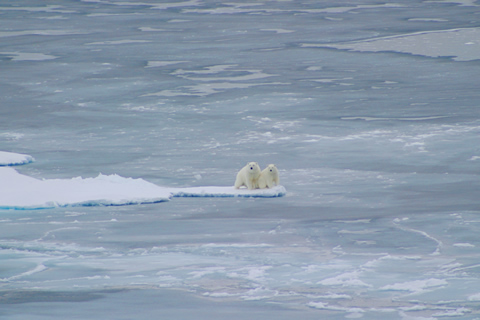A U of T scientist has discovered a way to track changes in Arctic sea ice going back almost 650 years, using bright pink algae that form crusts on rocks on the sea floor.
The study, published in the Proceedings of the National Academy of Sciences, suggests that the sea ice cover in the Canadian Arctic has shrunk dramatically over the past 150 years and not just since the 1970s, when satellites first began providing reliable data.
Jochen Halfar, a professor in UTM’s department of chemical and physical sciences, found that the growth rate of coralline algae depends on the water temperature and the amount of light the algae receive. As snow-covered sea ice accumulates on the water above, it chills the water and darkens the sea floor, slowing or stopping the plants’ growth. When the sea ice melts, the algae start growing more quickly again.
This cycle of dormancy and growth creates visible layers – like a tree’s rings — that researchers can use to determine how long each year the sea was ice-free. With colleagues from the Smithsonian Institution, Germany and Newfoundland, Halfar collected and analyzed samples of the algae, which can live for centuries and are found widely throughout the Arctic Ocean.
Halfar also measured the levels of magnesium preserved in each algal layer. Longer periods of open and warmer water result in a higher amount of magnesium being present in the algae.
Halfar’s research shows that during the Little Ice Age – a period of global cooling that lasted from the mid-1500s to the mid-1800s – the algae’s annual growth layers were as narrow as 30 microns (millionths of a metre), due to the extensive sea-ice cover – much narrower than in the preceding decades. Since 1850, however, the thickness of these layers has more than doubled, indicating a significant reduction in sea ice coverage.
Satellite data from the past 35 years show that Arctic sea ice cover has been shrinking an average of seven per cent per decade. In 2012, it declined to its lowest point since modern-day records began, 50 per cent below the average from 1979-2000.
Halfar says the coralline algae provide a new way to reconstruct climate history, which will enable scientists to predict future climate change more accurately. “In the north, there is nothing in the shallow oceans that tells us about climate, water temperature or sea ice coverage on an annual basis,” said Halfar. “These algae, which can potentially live for more than 1,000 years, can now provide us with that information.” In a new study, Halfar is working on specimens that date back to before the first millennium.
Recent Posts
U of T’s 197th Birthday Quiz
Test your knowledge of all things U of T in honour of the university’s 197th anniversary on March 15!
Are Cold Plunges Good for You?
Research suggests they are, in three ways
Work Has Changed. So Have the Qualities of Good Leadership
Rapid shifts in everything from technology to employee expectations are pressuring leaders to constantly adapt






One Response to “ Arctic Sea Ice in Century-Long Decline ”
Once again, evidence is emerging that challenges the accepted theory that climate change (what used to be called "global warming") is caused by human activity. First, it is not possible to use the scientific method to prove that climate change is caused by humans because we have no other Earth, or approximate Earth, without humans to compare to.
Second, of course there is climate change because that's what climate does: it changes! Climate alarmists use the same faulty logic that propelled the U.S. into the war in Iraq: "We do not have any proof that Saddam Hussein has weapons of mass destruction, but we don't have any proof that he doesn't have them either, so we'll invade." What if the real danger to humans is global cooling and the onset of a new ice age? The sun will do what it pleases and humans have no say in the matter.